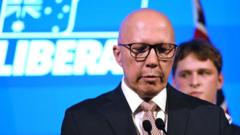Australia's political landscape has shifted dramatically following a disheartening defeat for the Liberal Party in the recent federal elections. The party's leader, Peter Dutton, has been ousted not only as the opposition leader but also lost his own seat in Dickson, marking a historic low for the party. This defeat has triggered an urgent need for reflection and change within the Liberal Party as they navigate the fallout.
In a striking referendum on leadership, the Australian electorate chose Labor’s Anthony Albanese as the new Prime Minister, casting a vote for unity over division. Dutton's loss comes at a time when Liberal strongholds in major metropolitan centers, including Sydney, Melbourne, Brisbane, and Adelaide, have eroded, leaving the party to reassess its direction.
Prominent members within the Liberal Party, like MP Keith Wolahan, have voiced concern over the electoral catastrophe and are demanding a thorough investigation into the factors contributing to their failure. Wolahan emphasized the importance of listening to the electorate and acknowledging that something went awry during the campaign.
Critics have pointed to what they term "the Dutton experiment" as a significant misstep, with former Liberal adviser Andrew Carswell bluntly labeling the defeat a catastrophe for the Coalition. Drawing comparisons to the polarizing figure of Donald Trump, many believe Dutton's campaign struggled to resonate with voters who are increasingly dissatisfied with divisive politics.
As the party faces an immediate leadership crisis, potential successors are being speculated upon, with figures like shadow treasurer Angus Taylor and deputy leader Sussan Ley among the frontrunners. The absence of a clear choice, however, leaves the party at a crossroads as it must regroup and strategize to regain the confidence of the electorate ahead of the next election cycle in 2025.


















